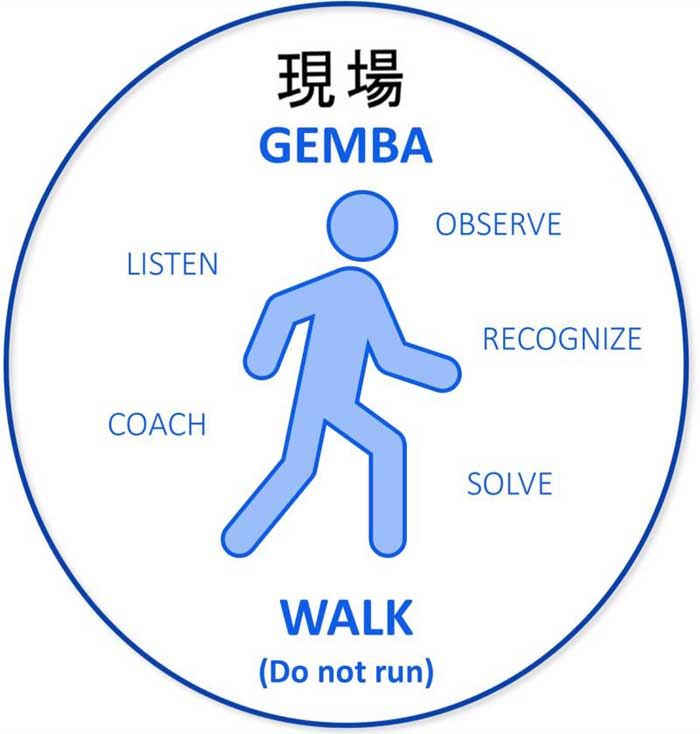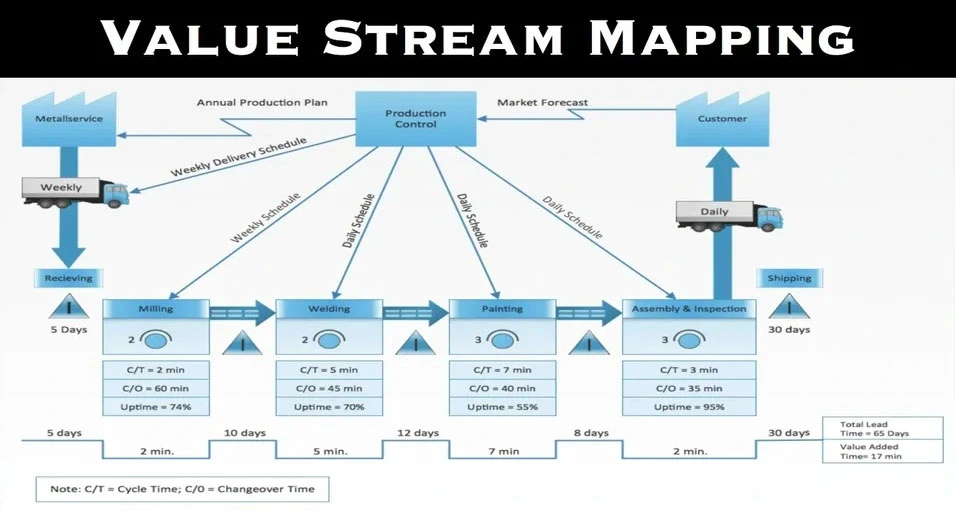LEAN MANUFACTURING TOOLS
Lean manufacturing is a production methodology focused on maximizing value for customers by eliminating waste and optimizing processes to improve efficiency, reduce costs, and enhance quality. Lean Manufacturing Tools help us achieve those goals.
Lean Manufacturing Tools:
Driving Efficiency and Waste Reduction
Lean manufacturing is a production philosophy that aims to maximize value while minimizing waste. Originating from the Toyota Production System (TPS), Lean focuses on improving process efficiency, reducing costs, and enhancing product quality by eliminating non-value-added activities. To achieve these objectives, several Lean Manufacturing tools are employed in manufacturing environments, including Overall Equipment Effectiveness (OEE), 5S, Andon, Kanban, Gemba, Value Stream Mapping, Kaizen, Plan-Do-Check-Act (PDCA), and Root Cause Analysis. These tools, when used effectively, can streamline operations, improve communication, and create a culture of continuous improvement.
5S: Organizing the Workplace for Efficiency
Of all the Lean Manufacturing tools, 5S is probably the first to be applied. 5S is a Lean methodology used to organize and standardize the workplace, leading to greater efficiency and safety. It consists of five steps:
- Sort (Seiri): Remove unnecessary items from the workplace to reduce clutter and create more space for efficient operations.
- Set in Order (Seiton): Organize tools, equipment, and materials so that they are easy to access and reduce time spent searching for items.
- Shine (Seiso): Keep the workplace clean and well-maintained, reducing the risk of errors and equipment malfunctions.
- Standardize (Seiketsu): Create standardized work procedures and routines to ensure consistency and efficiency.
- Sustain (Shitsuke): Develop a culture of discipline and continuous improvement to maintain the standards established through the previous steps.
By implementing 5S, manufacturers can reduce wasted time, prevent accidents, and improve overall workflow. The improved organization fosters a more productive and safe work environment, contributing directly to the efficiency of manufacturing processes.
Gemba: Going to the Source
Gemba, a Japanese term meaning “the real place,” refers to the practice of managers and supervisors going to the shop floor to observe the work being done firsthand. The idea is that problems and opportunities for improvement are best understood by seeing the process in action.
Rather than relying on reports or second-hand information, Gemba walks enable decision-makers to engage directly with employees, observe challenges, and understand the root causes of issues. This allows for more effective problem-solving, better communication between management and the workforce, and the identification of areas for improvement.
In addition to identifying waste and inefficiencies, Gemba emphasizes the importance of building relationships with frontline workers, creating a culture of collaboration and continuous improvement. Gemba walks can help foster a deeper understanding of the processes and lead to more informed decision-making.

Gemba enhances efficiency by encouraging managers to observe processes directly on the shop floor. This hands-on approach helps identify inefficiencies, bottlenecks, and waste in real time. By engaging with employees, managers can implement immediate improvements, streamline workflows, and optimize resource use. This continuous observation and problem-solving foster a culture of efficiency, leading to sustained productivity gains.
Kaizen: Continuous Improvement
Kaizen, meaning “change for the better,” is a Lean philosophy centered on continuous, incremental improvements. Rather than focusing on large, radical changes, Kaizen encourages small, consistent improvements that add up over time to create significant enhancements in efficiency and quality.
Kaizen involves every employee, from top management to frontline workers, and emphasizes teamwork, mutual respect, and a focus on solving problems at all levels. The practice includes regular Kaizen events, where teams identify specific areas for improvement and work together to implement solutions.
The Kaizen approach helps foster a culture of continuous improvement, where employees are encouraged to suggest improvements, solve problems, and take ownership of their work processes. This leads to ongoing enhancements in productivity, quality, and overall operational performance.
Plan-Do-Check-Act (PDCA): Structured Problem-Solving
The Plan-Do-Check-Act (PDCA) cycle is a structured, iterative approach to problem-solving and continuous improvement. This methodology ensures that changes and improvements are tested, evaluated, and refined over time. The PDCA cycle consists of four stages:
- Plan: Identify a problem or opportunity for improvement, set goals, and develop a plan for action.
- Do: Implement the plan on a small scale or in a controlled environment.
- Check: Analyze the results of the implementation to determine whether the goals were met.
- Act: Based on the findings, standardize the solution if successful or adjust the plan if necessary.
The PDCA cycle offers several benefits:
1. Continuous Improvement: It fosters a culture of ongoing improvement by encouraging regular evaluation and refinement of processes.
2. Problem-Solving: Helps identify root causes of issues and implement effective solutions.
3. Data-Driven Decisions: Encourages decisions based on facts and results, improving overall process efficiency.
4. Standardization: Successful changes are standardized, ensuring long-term improvements.
5. Flexibility: Adaptable to any process or industry, ensuring widespread applicability.

PDCA helps organizations systematically test and refine improvements, ensuring that changes lead to tangible benefits without unintended negative consequences. By following the PDCA cycle, manufacturers can continuously improve their processes, products, and services.
Andon: Real-Time Visual Management
Andon is a visual management system used to alert operators, supervisors, and managers about production issues in real time. Typically represented on a board or display, Andon systems use color-coded signals to indicate the status of a production line. For example:
- Green indicates the production line is running smoothly.
- Yellow signals a minor issue that needs attention.
- Red indicates a serious problem that requires immediate intervention.
Key metrics from machine monitoring systems such as Quantum Efficiency Management System are often integrated into Andon boards, displaying real-time data such as production rates, equipment status, and downtime. By providing this immediate visibility, Andon systems allow for faster decision-making, minimize production interruptions, and ensure that issues are addressed before they escalate into bigger problems. This real-time feedback loop helps maintain a smooth flow of operations and enhances productivity.
Overall Equipment Effectiveness (OEE)
OEE is a key Lean manufacturing metric used to measure the efficiency of a manufacturing process. It evaluates how effectively a machine or production line is utilized, taking into account availability, performance, and quality. OEE is calculated as:
OEE = Avaliability x Performance x Quality
Where:
- Availability measures the amount of time a machine is available for production versus downtime.
- Performance assesses how quickly a machine operates compared to its maximum speed.
- Quality indicates the percentage of products produced without defects.
By using OEE as a performance metric, manufacturers can identify inefficiencies, reduce downtime, and focus on areas where equipment is underperforming. Improvements in OEE often result in more efficient use of machinery, lower operational costs, and increased production capacity.
Value Stream Mapping: Analyzing and Improving Flow
Value Stream Mapping (VSM) is a Lean tool used to visualize and analyze the flow of materials and information through a production process. VSM provides a detailed map of each step in the manufacturing process, highlighting value-adding activities and identifying waste.
A typical VSM includes:
- Current state map: A visual representation of the existing process, showing the flow of materials, information, and bottlenecks.
- Future state map: A vision of an optimized process with reduced waste, improved flow, and greater efficiency.
- Action plan: A roadmap for implementing improvements and eliminating non-value-added activities.
By identifying inefficiencies in the value stream, manufacturers can prioritize areas for improvement, reduce cycle times, and improve overall process flow. VSM also helps align teams around common goals, providing a clear direction for continuous improvement efforts.

Value Stream Mapping (VSM) and Kanban are Lean tools that complement each other. VSM visualizes the entire production process, identifying inefficiencies and bottlenecks. Kanban, on the other hand, manages workflow and inventory by signaling when materials are needed. Together, VSM identifies improvement areas, while Kanban ensures smooth, just-in-time flow, reducing waste and optimizing production efficiency.
Kanban: Managing Inventory and Workflow
Kanban is a visual system for managing workflow and inventory levels in a just-in-time (JIT) production environment. The primary goal of Kanban is to reduce inventory waste and ensure that materials are available only when needed, eliminating overproduction and excess stock.
In a typical Kanban system, cards (or digital signals) are used to indicate when more materials or components are required. When a workstation consumes a material or part, it triggers a signal to the supplier or previous stage in the production process to replenish the inventory. This system ensures that production flows smoothly, preventing bottlenecks and excess stock.
Kanban also provides flexibility by allowing production to respond to real-time demand changes. By maintaining an optimal balance between supply and demand, manufacturers can avoid both stockouts and surplus inventory, contributing to reduced waste and cost savings.
Root Cause Analysis: Solving Problems at the Source
Root Cause Analysis (RCA) is a problem-solving tool used to identify the underlying causes of issues rather than just addressing the symptoms. By identifying the root cause, manufacturers can implement solutions that prevent the problem from recurring in the future.
Common RCA techniques include:
- The 5 Whys: Asking “why” multiple times (usually five) to drill down into the underlying cause of a problem.
- Fishbone Diagram (Ishikawa): A visual tool that categorizes potential causes of problems into major groups such as people, processes, materials, and equipment.
RCA is a critical tool for addressing recurring issues and ensuring that solutions are both effective and sustainable. By getting to the root cause, manufacturers can make long-term improvements that reduce waste, prevent defects, and enhance overall process reliability.
Conclusion
Lean manufacturing tools such as OEE, 5S, Andon, Kanban, Gemba, Value Stream Mapping, Kaizen, PDCA, and Root Cause Analysis are essential for driving efficiency, reducing waste, and continuously improving manufacturing processes. These tools help organizations identify bottlenecks, streamline operations, and optimize resource utilization while fostering a culture of continuous improvement. By integrating these Lean tools into daily operations, manufacturers can achieve greater productivity, improve product quality, and maintain a competitive edge in today’s fast-paced, cost-conscious marketplace. Through their combined use, companies can create a sustainable, efficient, and waste-free manufacturing environment.
Our Happy Customers











